Tie information library offers an initial resource without claiming to be legally binding. For detailed legally binding information as well as guidelines and regulations please refer to our main categories on our website, where we provide a link under each section. At the bottom of this page is a selection of frequently asked questions and answers from the public.
Greenhouse gas neutral, climate neutral – what does that mean?
There are multiple efforts at the political and social level to protect the climate. The terms used in this context are just as diverse. Greenhouse gas neutrality, climate neutrality or emission reduction are some of these buzzwords. But what do they actually mean and how do they differ? Before you delve into our topics, we recommend watching the following explanatory film. It explains and categorises all the important terms in an entertaining way. It is available in German only.
If you click on the YouTube symbol in the bottom right-hand corner of the video, you will be taken directly to the platform. You can also have subtitles displayed there.
Umweltbundesamt: Klimaschutzbegriffe erklärt
Ein Erklärfim zu den gläufigsten Begriffen und dessen Bedeutung im Klimaschutz.
Together against climate change
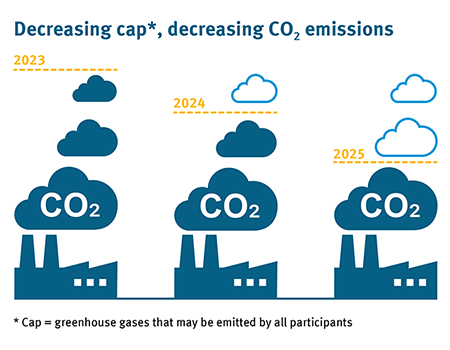
The Federal Republic of Germany, the European Union and the Member States of the UN Climate Change Conference are jointly trying to limit climate change to a minimum. To this end, various political instruments have been established at all levels. Emissions trading is an important element in this and it should contribute to reducing emissions in Germany to the level before industrialisation in the 19th century by 2045. Its goal is to achieve climate neutrality at the lowest economical cost and as quickly as possible. Many greenhouse gases are also emitted during production processes outside Europe. That is why the Carbon Border Adjustment Mechanism has been in place since 2023. This ensures fair competition and also provides incentives for more climate-friendly production outside Europe. We, the German Emissions Trading Authority (DEHSt) at the German Environment Agency, are responsible for emissions trading, the Carbon Border Adjustment Mechanism and other enforcement activities in Germany.
Explanatory film by the Federal Environment Ministry
Film is available in German only.
Kurz erklärt: CO2-Preis, Klimaschutzprogramm und Klimaschutzgesetz
What is an emissions trading system?
Greenhouse gas emissions contribute significantly to global warming and climate change. To ensure that the producers of such emissions have an economic incentive to reduce emissions, there are currently two different comprehensive emissions trading systems in Germany. Both have the following principle in common: anyone who pollutes the air with greenhouse gases pays a price, directly or indirectly, for each tonne of CO2 equivalent by purchasing pollution rights. CO2 is the chemical formula of carbon dioxide. All gases that trigger a greenhouse effect are referred to as CO2 equivalents (CO2eq). For this purpose, the harmfulness of methane, for example, is compared with that of carbon dioxide and specified as CO2 equivalent.
Emissions trading implements the ‘cap and trade’ principle. The cap set by the state is a political decision about the maximum total amount of CO2 equivalents (CO2eq) that can be emitted. A cap that is demanding in terms of climate policy ensures that CO2 becomes a scarce commodity and that a price for CO2 is formed on the market through trade, which creates an incentive to invest in more climate protection.
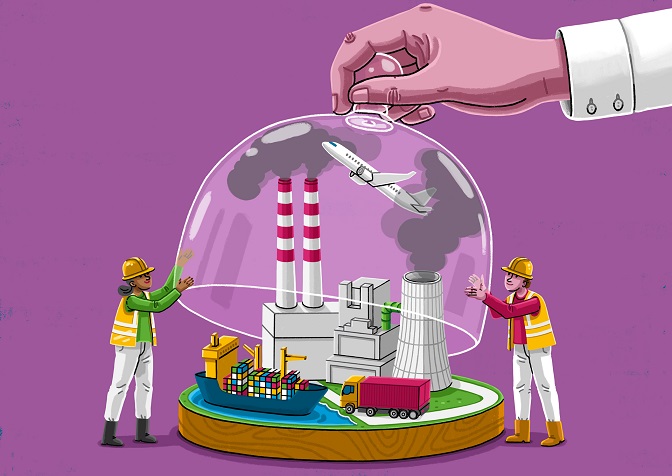
All companies that participate in emissions trading, being either installations, ships or aircraft based, according to legal provisions must surrender one emission allowance for each tonne of CO2eq emitted. A limited number of emission allowances are made available free of charge to some of the companies from the cap in accordance with allocation rules specified throughout Europe. Companies that do not receive free emission allowances or for which the allocation is insufficient must buy emission allowances at regular auctions or from other companies. If they have been allocated more emission allowances than they need, they can sell them. This is where the term emissions trading comes from. Strictly speaking, it is not emissions but allowances that are traded to be allowed to emit the corresponding amount of greenhouse gases.
The auctions and trading between the companies result in a market price for the emission allowances. If there are a lot of emission allowances available (supply) in relation to the companies' emissions (demand), the market price is low. If, on the other hand, emission allowances become scarce, for example because fewer allowances are available to meet climate protection targets, the price rises.
Higher prices create incentives for more and more companies to introduce climate protection initiatives to reduce their greenhouse gas emissions. After all, if it is cheaper to prevent a tonne of CO2eq than to buy an emissions allowance, it is worth taking technical initiatives. The possibilities here range from simple optimization of processes to investments in modern production facilities.
The term CO2 tax is still often erroneously bandied about amongst the general public. As a result, we frequently receive enquiries asking for information about possible tax relief. However, since the revenues are designated for a specific group of people, this is not a tax.
Factsheet
Factsheet available in German only.
What emissions trading systems are there?
In Germany, there is a European emission trading 1 and the national emissions trading, which is expected to be incorporated into the European Emissions Trading 2 from 2027. Together, they cover the transport, heating, energy, industry, maritime transport and aviation sectors, which accounted for around 85 percent of total 2021 greenhouse gas emissions in Germany.
European emissions trading 1 - Stationary
The stationary European Emissions Trading System 1 (EU ETS 1) starts where emissions are generated in large industrial installations, in power plants, maritime transport and in intra-European air traffic. Operators, ship operators or airlines must purchase emission allowances (that is the previously mentioned pollution rights) for the emissions they cause (this is called downstream emissions trading). The European Commission has set a binding cap on the total Europe-wide CO2 emissions for each year. These pollution rights are allocated proportionally to all Member States. The competent authorities allocate a portion of these allowances to operators and airlines free of charge. If a company emits fewer CO2 equivalents than it was allocated free of charge, it can sell the surplus emission allowances to other participants. If the free allocations are not sufficient, further emission allowances must be purchased from other participants or from the relevant auction platform. In Germany, we, the German Emissions Trading Authority, are responsible for allocating pollution rights. Auctioning takes place on our behalf at the European Energy Exchange (EEX) in Leipzig. The limiting and trading of these rights is called "cap & trade".

Regulated companies must provide us with an annual emissions report detailing how much CO2 equivalent they have emitted. Strict monitoring plans and verification by accredited verifiers guarantee accurate acquisition of true emission data.
At the end of the cycle, emission allowances are surrendered equalling the reported and verified volume of emissions. If the participants do not fully comply, severe sanctions will follow.
Emissions Trading – Economics and Climate Protection
Production: joernbarkemeyer.de
European emissions trading 1 - Aviation
The European Emissions Trading Scheme 1 for aviation has so far only covered CO2 emissions. However, these gases only account for around a third of the greenhouse gas effect in aviation. The remaining two thirds are due to so-called “non-CO2 effects”.
Depending on the climate zone and flight altitude, contrails from aircraft engines as well as nitrogen oxide and water vapor, among other things, can have a much greater negative impact on the climate. These effects have not yet been taken into account in climate protection instruments. Since 2015, the UBA has been pointing out this gap and, through intensive consultation, has ensured that these effects will be included in the European Emissions Trading System 1 (EU ETS 1) with a reporting obligation from 2025.
To minimize the climate impact, the additional introduction of a levy obligation for non-CO2 effects - converted into CO2 equivalents - is considered key. Research in this area is already sufficiently advanced, although it is very challenging, particularly with regard to identifying the effects of individual flights. This is because the non-CO2 effects can vary depending on the flight route.
Airlines can minimize non-CO2 effects by using more economical engines, sustainable fuels and adapted flight routes.
EU ETS 1 – Maritime transport
Shipping was not included in the European Emissions Trading System for a long time. However, since 2018, ships calling at European ports have been obliged to monitor and report their emissions. The European Union has decided to include shipping in the EU ETS 1 on a mandatory basis from 2024. This decision aims to strengthen control over the impact of maritime transport on air pollution and climate change. Maritime transport companies will then have to purchase emission allowances. This should keep greenhouse gas emissions within the established limits.
Specifically, ships with a gross tonnage of 5,000 tonnes or more must participate in EU ETS 1. This in particular applies to ships that operate between ports in the European Economic Area. By participating in EU ETS 1, shipping companies must purchase emission allowances for the greenhouse gas emissions generated by their entire fleet and submit reports on their emissions.
The introduction will take place in stages:
2024: All emissions must be reported. Certificates must be surrendered for 40 percent of CO2 emissions.
2025: Certificates must be surrendered for 70 percent of CO2 emissions.
2026: 100 percent of all CO2, methane and nitrous oxide emissions are subject to emissions trading.
National emissions trading
The national emissions trading system () has a different approach: it compels fuel distributors to purchase pollution rights in the form of certificates (this method is called upstream emissions trading). In other words, they pay for the emissions that result from the subsequent combustion of the fuels after having been placed on the market.
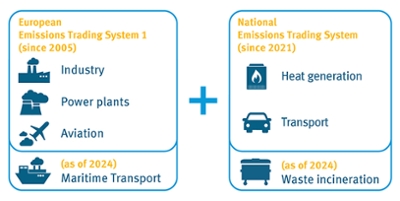
he sectors involved can explain the different approaches of the two systems. The transport and heating sectors involve a large number of emitters, such as car drivers and home owners who use fossil fuels for mobility or heating.
The distributors are obliged to participate in order that the customers do not have to partake directly in national emissions trading. They then transfer the additional costs to the consumers. When prices rise, the incentive for end users to reduce their own carbon footprint will increase.
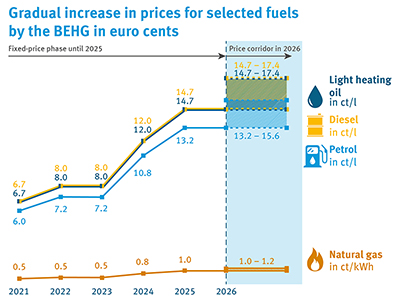
We are currently still in a fixed-price phase during which the price of certificates is politically determined rather than set by the market. This phase ends in 2025. After that, the price will be determined within a corridor until 2027. The current price levels are increasingly affecting consumer prices. For diesel, super unleaded petrol and light heating oil, the increases are between 13 and 15 cents per litre. For natural gas, it is 1 cent.
In national emissions trading, the amount of fuel placed on the market and the potential CO2 emission must also be reported. The DEHSt platform can be used for reporting this and the fuel-to-CO2-equivalents conversion. When there is no special situation, the energy tax declaration data suffices. A monitoring plan is only envisaged for the 2023 reporting year.
At a European level, an emissions trading system is expected to be introduced for those emissions not subject to the existing EU ETS 1 from 2028 at the latest.
National Emissions Trading
Our explanatory film shows how national emissions trading works and illustrates its positive impact on climate protection.
Source: Production: joernbarkemeyer.de
European Emissions Trading 2 (EU ETS 2)
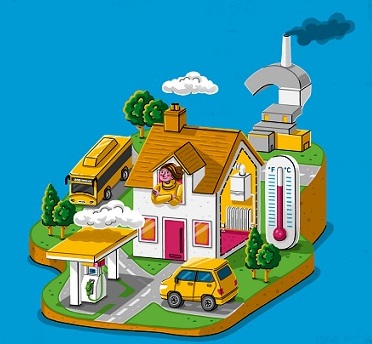
Between 2005 and 2023, the emissions of companies participating in the EU ETS 1 fell by 48 percent. This is a great achievement but is not enough to meet the ambitious climate protection goals and to minimise global warming.
That is why a new emissions trading system for fuels in the transport and building sectors will be implemented across Europe from 2027. This system takes the same upstream approach as national emissions trading, which will then be partially or fully incorporated into the new system.
The transitional phase is already underway, during which those responsible must report their emissions to us in accordance with the monitoring plan. The obligation to surrender allowances will then begin. The legal framework is currently being created in Germany.
UBA Factsheet (2023): Introduction of an emissions trading system for buildings, road transport and additional sectors in the EU
Who can participate in emissions trading?
Participation in trading or choosing offsetting is open to all in both European and national emissions trading. The situation is different when it comes to the obligation to surrender and reporting as well as the entitlement to allocation. We openly welcome all private endeavours that contribute to climate protection, but we cannot reward them through the allocation of ‘certificates’ (emission allowances or emission certificates). Only operators, aircraft operators and fuel distributors are obliged to participate. The legal framework for this has been created by the Greenhouse Gas Emissions Trading Act (TEHG for the EU ETS 1) and the Fuel Emissions Trading Act ( for the ). This means that no ‘certificates’ can be issued for emission reductions from photovoltaic installations, hydropower plants or from afforestation of private forests. For information about when and who is obliged to trade emissions, please see our basic pages on the and EU ETS 1 or the relevant legal texts.
Those who are not obliged to participate in one of the emissions trading systems and would like to offset unavoidable emissions can still do so voluntarily. The German Environment Agency offers a CO2 calculator for this purpose, and we provide information on the acquisition of emission reduction credits on the pages linked below. If you would like to actively contribute to climate protection, you can calculate the emissions of your next holiday, for example, using the CO2 calculator and purchase credits from one of many providers.
Who is obliged?
Stationary Installations (EU ETS 1)
National emissions trading (nEHS)
Calculate emissions and compensate voluntarily
Partly available in German only.
CO2-Rechner des Umweltbundesamts
What are (emission) certificates?
From a technical perspective, certificates are special tools designed to establish the identity of a person or to encrypt documents thus enabling secure transmission over the internet while maintaining legal validity.
The term emission certificate is usually used as an umbrella term for emission allowances, certificates in national emissions trading and also for older units that are no longer used. An emission allowance is a record in an electronic database, that is registry. A certificate is always held in an account and the account holder is the owner of that certificate.
European emissions trading 1: Within the European Emissions Trading System we speak of emission allowances and not certificates. An emission allowance (EA) enables operators or aircraft operators to emit one tonne of carbon dioxide equivalent. Participating companies receive a number of allocations free of charge, which are reduced annually (cap). If the allocation amount is not sufficient to offset emissions, the company must purchase additional allowances. Allowances can be traded among the operators (trade) and can be auctioned on the Leipzig Energy Exchange EEX. Unlike the Frankfurt Stock Exchange, emission allowances can only be procured through auctions on this platform. Because of this and the fact that their expiry date is finite, it is not possible to use certificates for speculative investment auctioning.
European Emissions Trading System 2: In this system, the certificates will be called ‘Emission Certificates’ starting as soon as 2027, when they have to be surrendered. This could lead to confusion among experts because the certificates in national emissions trading originally had this name.
National emissions trading: In national emissions trading, distributors must purchase emission allowances (nEZ) for the potential greenhouse gas emissions of their fuels. These are also only valid for a limited time and must also be traded or purchased on the Leipzig Energy Exchange (EEX). A fixed price phase applies to the nEZs up to 2025, during which the prices are increased annually.
Voluntary offsetting: If certain activities with high emissions cannot be avoided, voluntary offsetting of greenhouse gases offers an option to offset emissions that have been generated. In this way, individuals, companies, or organisations can offset their remaining emissions and make an individual contribution to climate protection without being obliged to do so. To achieve this, the person whose activities cause greenhouse gas emissions finances certain initiatives with the result of reducing greenhouse gas emissions elsewhere. Various certificates can be procured for this purpose, but they are not eligible for subsequent trading.
All transactions are tracked in registries similar to online banking. Certificates from different trading systems cannot be mixed with each other.
Further information on emission allowances
Further information on certificates
How can carbon leakage be prevented?
In a globalised world, there is a risk that companies will relocate investments or production to a country where no additional costs arise due to emissions trading. This would contradict climate protection because accompanying emissions would also be relocated. The risk of such an emission shift is called carbon leakage. There are different approaches in the EU ETS 1 and in the nEHS to address this risk aiming to prevent the relocation of production sites.
You can find more information about the various procedures on the articles below.
Read our articles
Protection against Carbon Leakage
Understanding electricity price compensation (SPK)
What happens to the revenues from emissions trading?

European and national emissions trading generated revenues of 13.6 billion euros in 2022. They are earmarked to flow into the Climate and Transformation Fund (KTF) and open up a new scope of government support for climate protection initiatives. They are also used to stabilise electricity costs in Germany on a proportionate basis, to pay out State aid on offsetting and to finance enforcement.
Press release on the revenues 2023
Emissions trading rings up record revenues: More than 13 billion euros for climate protection
EU ETS 1: Use of revenues from European emissions trading
: Revenues from national emissions trading
Carbon border adjustment mechanism (CBAM)
CBAM is part of the European ‘Fit for 55’ package and obligates companies that import high emission goods into the EU to purchase CBAM emission allowances to compensate for the difference between the CO2 price paid in the country of origin and the higher price of the allowances in the EU Emissions Trading System. The system affects a large number of industrial and trading companies.
CBAM has been introduced starting gradually in October 2023 in order to slowly familiarise participating companies inside and outside the EU with the reporting obligations and methods for determining embedded emissions in accordance with the requirements of the EU Emissions Trading Scheme. Initially, the instrument only applies to electricity, cement, iron and steel, aluminium, fertilisers and hydrogen. The processes used to manufacture these products are accompanied by particularly high CO2 emissions and therefore exposed to a high risk of carbon leakage (CL).
CBAM’s principle is that the same CO2 price applies to imported and EU-manufactured products. The problem is that European emissions trading has made the production of high emission goods in Germany and the EU more expensive. If industrial raw materials and goods from other countries are now also subject to a CO2 price in the EU, this protects against competitive disadvantages and ‘carbon leakage’ (emission increase due to the relocation of industrial production abroad, where little or no CO2 pricing is applied to the manufactured goods). The prior practice of granting industrial companies a free allocation of emission allowances to guard against direct carbon leakage through the EU ETS 1 is then no longer necessary. This allows the CO2 price in the EU to operate with greater effectiveness. In addition, carbon price for imports also creates financial incentives for companies in third countries to protect the climate. CBAM therefore combines carbon leakage protection and effective CO2 pricing. The EU's aim is to promote effective methods of decarbonisation worldwide.
EU tax and customs: Carbon Border Adjustment Mechanism in 60 seconds video


